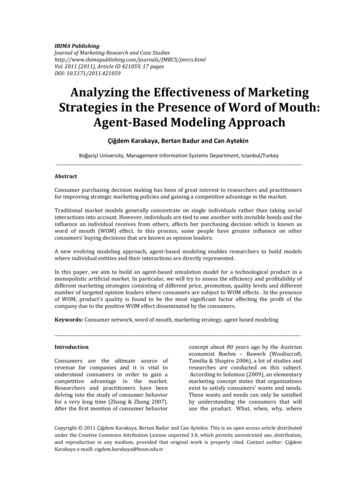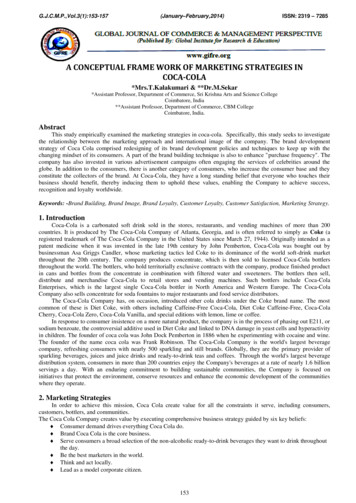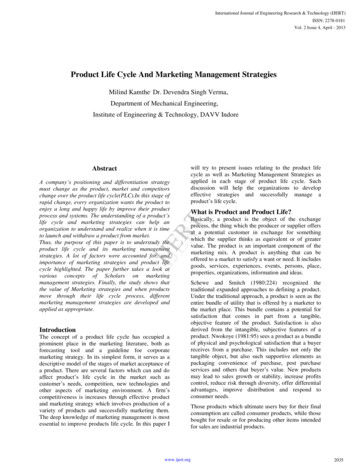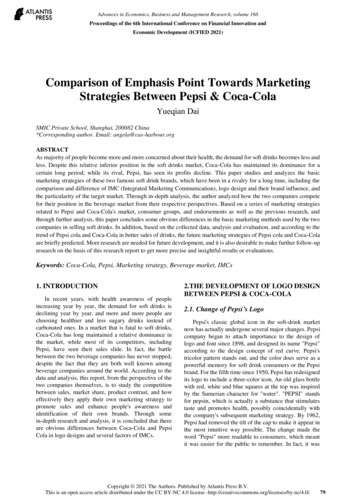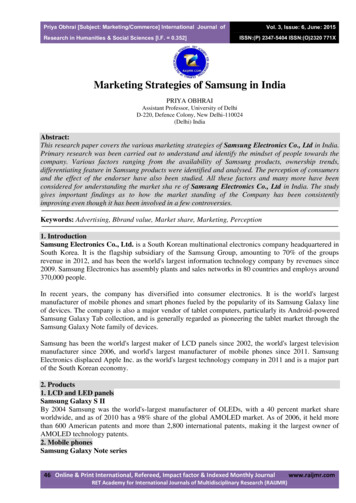
Transcription
Priya Obhrai [Subject: Marketing/Commerce] International Journal ofResearch in Humanities & Social Sciences [I.F. 0.352]Vol. 3, Issue: 6, June: 2015ISSN:(P) 2347-5404 ISSN:(O)2320 771XMarketing Strategies of Samsung in IndiaPRIYA OBHRAIAssistant Professor, University of DelhiD-220, Defence Colony, New Delhi-110024(Delhi) IndiaAbstract:This research paper covers the various marketing strategies of Samsung Electronics Co., Ltd in India.Primary research was been carried out to understand and identify the mindset of people towards thecompany. Various factors ranging from the availability of Samsung products, ownership trends,differentiating feature in Samsung products were identified and analysed. The perception of consumersand the effect of the endorser have also been studied. All these factors and many more have beenconsidered for understanding the market sha re of Samsung Electronics Co., Ltd in India. The studygives important findings as to how the market standing of the Company has been consistentlyimproving even though it has been involved in a few controversies.Keywords: Advertising, Bbrand value, Market share, Marketing, Perception1. IntroductionSamsung Electronics Co., Ltd. is a South Korean multinational electronics company headquartered inSouth Korea. It is the flagship subsidiary of the Samsung Group, amounting to 70% of the groupsrevenue in 2012, and has been the world's largest information technology company by revenues since2009. Samsung Electronics has assembly plants and sales networks in 80 countries and employs around370,000 people.In recent years, the company has diversified into consumer electronics. It is the world's largestmanufacturer of mobile phones and smart phones fueled by the popularity of its Samsung Galaxy lineof devices. The company is also a major vendor of tablet computers, particularly its Android-poweredSamsung Galaxy Tab collection, and is generally regarded as pioneering the tablet market through theSamsung Galaxy Note family of devices.Samsung has been the world's largest maker of LCD panels since 2002, the world's largest televisionmanufacturer since 2006, and world's largest manufacturer of mobile phones since 2011. SamsungElectronics displaced Apple Inc. as the world's largest technology company in 2011 and is a major partof the South Korean economy.2. Products1. LCD and LED panelsSamsung Galaxy S IIBy 2004 Samsung was the world's-largest manufacturer of OLEDs, with a 40 percent market shareworldwide, and as of 2010 has a 98% share of the global AMOLED market. As of 2006, it held morethan 600 American patents and more than 2,800 international patents, making it the largest owner ofAMOLED technology patents.2. Mobile phonesSamsung Galaxy Note series46 Online & Print International, Refereed, Impact factor & Indexed Monthly JournalRET Academy for International Journals of Multidisciplinary Research (RAIJMR)www.raijmr.com
Priya Obhrai [Subject: Marketing/Commerce] International Journal ofResearch in Humanities & Social Sciences [I.F. 0.352]Vol. 3, Issue: 6, June: 2015ISSN:(P) 2347-5404 ISSN:(O)2320 771XSamsung's flagship mobile handset line is the Samsung Galaxy S, which many consider a directcompetitor of the Apple iPhone. It sold more than one million units within the first 45 days on sale inthe United States.The company's I9000 Galaxy S and S8500 Wave smart phones were the winners of the 2010 EuropeanEISA Awards in the smart phone and social media phone categories.At the end of the third quarter of 2010, the company had surpassed the 70 million unit mark in shippedphones, giving it a global market share of 22 percent, trailing Nokia by 12 percent. Overall, thecompany sold 280 million mobile phones in 2010, corresponding to a market share of 20.2 percent.Partially owing to strong sales of the Samsung Galaxy range of smart phones, the company overtookApple in worldwide Smart phone sales during the third quarter 2011, with a total market share of 23.8percent, compared to Apple's 14.6-percent share. Samsung became the world's largest cell phone makerin 2012, with the sales of 95 million smart phones in the first quarter.During the third quarter of 2013, Samsung's smart phone sales were boosted by a strong consumerreception in emerging markets such as India and the Middle East, where lower-priced handsets werepopular. As of October 2013, the company offers 40 smart phone models on its US website.3. SemiconductorsSamsung DDR-SDRAMSamsung Electronics has been the world's-largest memory chip maker since 1993. In 2010, marketresearcher IC Insights predicted that Samsung would become the world's-biggest semiconductor chipsupplier by 2014, surpassing Intel. For the ten-year period from 1999 to 2009, Samsung's compoundannual growth rate in semiconductor revenues has been 13.5 percent, compared with 3.4 percent forIntel.4. TelevisionsIn 2009, Samsung sold around 31 million flat-panel televisions, enabling to it to maintain the world'slargest market share for a fourth consecutive year.Samsung sold more than one million 3D televisions within six months of its launch. This is the figureclose to what many market researchers forecast for the year's worldwide 3D television sales (1.23million units).In 2007, Samsung introduced the Internet TV, enabling the viewer to receive information from theInternet while at the same time watching conventional television programming. Samsung laterdeveloped "Smart LED TV" (now renamed to "Samsung Smart TV"), which additionally supportsdownloaded apps. In 2008, the company launched the Power Info link service, followed in 2009 by awhole new Internet@TV. In 2010, it started marketing the 3D television while unveiling the upgradedInternet@TV 2010, which offers free (or for-fee) download of applications from its Samsung Apps appstore, in addition to existing services such as news, weather, stock market, YouTube videos, andmovies.Samsung Apps offers for-fee premium services in a few countries including Korea and the UnitedStates. The services will be custom-tailored for each region. Samsung plans to offer family-orientedapplications such as health care programs and digital picture frames as well as games. Samsung's rangeof smart TVs includes the apps ITV Player and motion controlled Angry Birds.5. OthersSamsung GX-10 digital SLR cameraSamsung produces printers for both consumers and business use, including mono-laser printers, colorlaser printers, multifunction printers, and enterprise-use high-speed digital multifunction printermodels.47 Online & Print International, Refereed, Impact factor & Indexed Monthly JournalRET Academy for International Journals of Multidisciplinary Research (RAIJMR)www.raijmr.com
Priya Obhrai [Subject: Marketing/Commerce] International Journal ofResearch in Humanities & Social Sciences [I.F. 0.352]Vol. 3, Issue: 6, June: 2015ISSN:(P) 2347-5404 ISSN:(O)2320 771XIn the area of storage media, in 2009 Samsung achieved a ten percent world market share, driven by theintroduction of a new hard disk drive capable of storing 250 Gb per 2.5-inch disk. In 2010, thecompany started marketing the 320Gb-per-disk HDD, the largest in the industry. In addition, it wasfocusing more on selling external hard disk drives. Following financial losses, the hard disk divisionwas sold to Seagate in 2011.3. ObjectiveThe basic idea of taking up this research study is to analyze the market share of SAMSUNG consumerdurables and mobile phones in Delhi. At the same time an attempt was made to understand the brandimage of SAMSUNG in India. To analyze who are the major players of consumer durables and mobile phones in the market. To study the market share of Samsung electronics. To study the brand value of Samsung.4. Literature reviewMarketing comes in a wide variety of flavors based on audience, media platform and business intoday’s evolving and dynamic marketplace. Therefore, it’s no surprise that marketers define what theydo differently.To start, here are explanations from the American Marketing Association (AMA), marketing’sprofessional organization, and Dr. Philip Kotler, the author of business school marketing classics.They’re followed by the other definitions in alphabetical order by author’s last name.Dr. Philip Kotler defines marketing as “the science and art of exploring, creating, and deliveringvalue to satisfy the needs of a target market at a profit. Marketing identifies unfulfilled needs anddesires. It defines, measures and quantifies the size of the identified market and the profit potential. Itpinpoints which segments the company is capable of serving best and it designs and promotes theappropriate products and services.”4.1 Marketing strategyMarketing strategy is defined by David Aaker as a process that can allow an organization toconcentrate its resources on the optimal opportunities with the goals of increasing sales and achieving asustainable competitive advantage. Marketing strategy includes all basic and long-term activities in thefield of marketing that deal with the analysis of the strategic initial situation of a company and theformulation, evaluation and selection of market-oriented strategies and therefore contributes to thegoals of the company and its marketing objectives.According to Shaw, Eric (2012)."Marketing Strategy: From the Origin of the Concept to theDevelopment of a Conceptual Framework”. Journal of Historical Research in Marketing., there is aframework for marketing strategies.Samsung's Marketing Strategy in India4.2 Product InnovationSamsung's product range in India included CTVs, audio and video products, information technologyproducts, mobile phones and home appliances. Its product range covered all the categories in theconsumer electronics and home appliances. Analysts felt that the wide product range of Samsung wasone of main reasons for its success in the Indian market. Samsung positioned itself on the technologyplatform.1. PricingPricing also seemed to have played a significant role in Samsung's success.48 Online & Print International, Refereed, Impact factor & Indexed Monthly JournalRET Academy for International Journals of Multidisciplinary Research (RAIJMR)www.raijmr.com
Priya Obhrai [Subject: Marketing/Commerce] International Journal ofResearch in Humanities & Social Sciences [I.F. 0.352]Vol. 3, Issue: 6, June: 2015ISSN:(P) 2347-5404 ISSN:(O)2320 771X2. DistributionAlong with the launch of new products, Samsung also consolidated its distribution system. Samsunghad 18 state-level distribution offices and a direct dealer interface. The direct dealer interface helpedthe company get quick feedback from dealers, and enabled it to launch products according to consumerneeds.3. Advertising and Sales PromotionIn 1995, when Samsung entered India, it realized that Indian consumers were not familiar with thecompany. So, in order to establish itself in the Indian consumers' mind, Samsung launched corporateadvertisements highlighting its technologically superior goods.4. Research MethodologyThe researcher has followed descriptive research.Descriptive research is used in this project report in order to identify the brand value of Samsung inIndia. This is the most popular type of research technique, generally used in survey research design andmost useful in describing the characteristics of consumer behaviour. The method used wasquestionnaire and interview of the Samsung customers was taken.The essential part of any report is research methodology. The field study was conducted to analyze themarket share and understand the brand image of Samsung products. The sample size was 100. 60%males and 40% females was the ratio of the respondents in this survey. The age of the respondents wasin the following proportion: Less than 18 years - 06.67% 18-22 years - 36.67% 22-2 years - 30.00% 26-30 years - 16.67% Greater than 30 years - 10%These numbers show that most of the respondents are youngThe occupation of the respondents was also kept in mind while conducting the survey to have acomplete and comprehensive analysis. The occupation of the respondents was in the followingproportion: College students - 46.67% Business man- 16.67% Working population - 20% Others - 16.67%Data used in this report is mainly primary data, which is collected first hand by survey in the field. Insome areas secondary data has also been used.5. Method of data collection5.1 Collection of primary dataThe source of the primary data is the population sample from which you collect the data. The data wascollected through the primary source by survey method using questionnaire and taking respondent’spersonal interview.5.2 Collection of secondary dataSecondary data analysis saves time that would otherwise be spent collecting data and, particularly inthe case of quantitative data, provides larger and higher-quality databases that would be unfeasible forany individual researcher to collect on their own. In addition, analysts of social and economic changeconsider secondary data essential, since it is impossible to conduct a new survey that can adequatelycapture past change and/or developments. The data is collected from journals and trusted internetsources.49 Online & Print International, Refereed, Impact factor & Indexed Monthly JournalRET Academy for International Journals of Multidisciplinary Research (RAIJMR)www.raijmr.com
Priya Obhrai [Subject: Marketing/Commerce] International Journal ofResearch in Humanities & Social Sciences [I.F. 0.352]Vol. 3, Issue: 6, June: 2015ISSN:(P) 2347-5404 ISSN:(O)2320 771X5.3 Data Analysis & InterpretationOwnership Trends of Samsung Products3%From the above chart, it can be observed that therespondents use Samsung products- mobile (63.33%),Tablet (3.33%), TV (6.67%), Home apps (10%),PC/Laptop (3.33%) and others (13.33%). These numbersshow that Samsung mobile are in the hands of most ofthe customers.Mobile13%TabletTV10%7%64%3%Home Apps5.4 Frequency of changing mobile phonesPC/Laptop3%Others7%Less than 1 year20%1-2 yearsFrom the a
09.08.2017 · Samsung's Marketing Strategy in India 4.2 Product Innovation Samsung's product range in India included CTVs, audio and video products, information technology products, mobile phones and home appliances. Its product range covered all the categories in the consumer electronics and home appliances. Analysts felt that the wide product range of Samsung was



